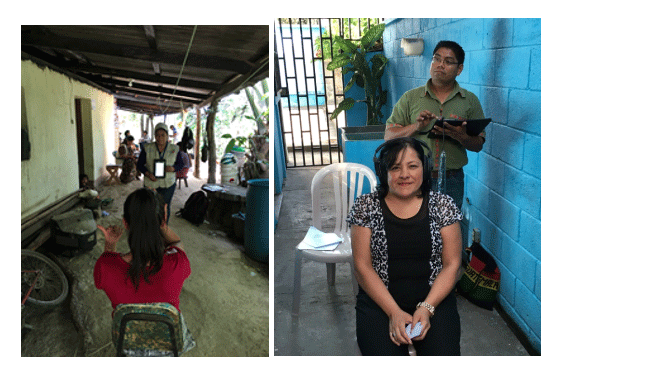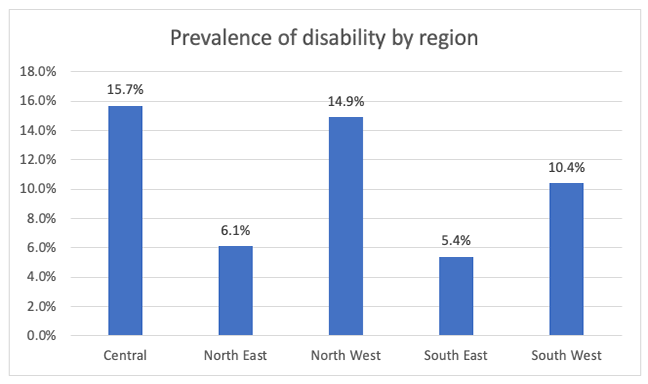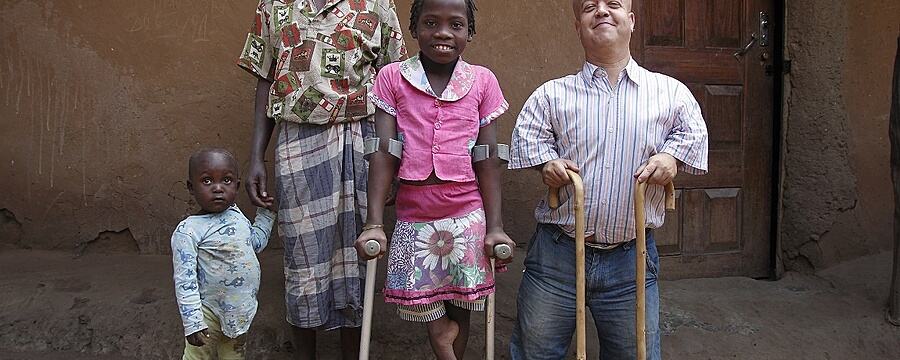Global Disability: Case Study in Guatemala
Introduction
Population-level data on disability are essential to inform and motivate evidence-based advocacy and disability inclusive policy and programmes. However, these data are lacking in many countries. To address this data gap in Guatemala, we conducted a study to estimate the prevalence of disability and to compare the experiences of people with and without disabilities in key life areas including work, education, health and water and sanitation.
The study, conducted between June and October 2016, was a collaborative project between The National Disability Council of Guatemala (CONADI), UNICEF Guatemala, CBM and the International Centre for Evidence in Disability (ICED) at LSHTM.
What methods did we use?
1) Measuring the prevalence of disability:
We conducted a population-based survey to estimate the prevalence of disability in Guatemala. We selected a sample of 13,800 people, throughout the country, using random sampling methods so it was representative of the whole population. To assess for disability, participants were interviewed using the Washington Group Extended Set of questions for adults and UNICEF/Washington Group extended set of questions for children. We introduced these tools in Step 2.2. They ask about reported difficulties in different functional domains (seeing, hearing, walking, communication and cognition, anxiety and depression). As the picture below shows, we also used mobile-based tools to test people’s vision, hearing and physical functioning (see Step 2.4). All data were collected on android tablets using a bespoke app developed for this study.

Testing for vision and hearing impairments in the Guatemala National Disability Survey. Copyright: ICED, LSHTM
2) Measuring differences between people with and without disabilities:
We used a nested case-control study (see Step 1.11) to compare the lived situation for people with and without disabilities in key life areas. The ‘cases’ were people with disabilities identified in the survey. For each case, we selected a ‘control’ without a disability of the same sex, age (+/-5 years) and from the same community as the case. Cases and controls were interviewed, in their homes, using a standardised questionnaire. The life areas we collected information on included work, education, health, water sanitation and hygiene, quality of life and participation. Table 1 shows examples of the types of information we collected within these areas.
3) Exploring experiences of people with disabilities
We also conducted a qualitative study; in-depth interviews were used to explore the experiences of people with disabilities in greater depth. Therefore, this study used mixed methods (see Step 1.15).
Table 1: Examples of outcomes measured to compare people with and without disabilities
| Life area | Examples of data collected |
|---|---|
| Work | Whether currently working/worked in past year, Types of work undertaken, Work security, Barriers to working |
| School | Attendance at school, Grade/level of school, Days of school missed, Access to school facilities (e.g. water, toilets) |
| Health | Frequency of seeking health care, Experience of seeking health care (including: Attitude of health workers, Ease of understanding information/communicating with health professionals), Barriers to seeking health care |
| Water, Sanitation and Hygiene | Types of toilet facilities and water sources used, Difficulties using toilet facilities/accessing water sources, Need for assistance using toilet facilities/accessing water |
| Participation | Level of difficulty performing various activities (e.g. related to self-care, domestic, school, community) in their current environment |
| Environment | Frequency and severity of problem with different environmental barriers (e.g. inaccessible transport, negative attitudes) |
| Quality of life1 | Measured using the World Health Organisation Quality of Life-Bref (WHO-QOL-Bref) [REF] which includes 26 questions across four domains: physical health, psychological health, social relationships and the environment |
What did the study tell us?
Disability is common in Guatemala: according to the survey findings 10.2% of the population have a disability and a third (31%) of all households include at least one person with a disability. Disability prevalence varied quite markedly between regions (see figure 1).

Figure 1: Prevalence of disability by region
The case-control study highlighted that people with disabilities across Guatemala face significant restrictions accessing services and participating in key life areas. Some of these findings are summarised below. For more details, please see the full study report (in the See Also section).
Work
Adults with disabilities were less likely to be working (23%) compared to their peers without disabilities (47%) (Figure 2). They also had less stable work opportunities: they were more likely than adults without disabilities to report working only occasionally rather than throughout the year.
One respondent in the qualitative study described the difficulties they faced finding work since they had become disabled:
“When I was in good shape, I went to the fields and worked. I worked in agriculture. Now that I cannot, I no longer go out, things have changed a lot because I cannot do what I did before…when one is good, one takes to the fields to cut the wood, to grow his crop, and brings it home… and catches fish so the family can eat….but now I am no longer able to do all this.”
“Knowing how many people with disabilities we are, makes this historically excluded sector visible on the country agenda, and focuses the State on meeting the requirements of this population. We can use these results for advocacy to promote concrete actions and the creation of programs that guarantee the rights of the population with disability living in exclusion and vulnerability.”
Questions to consider:
- What do you think the advantages and disadvantages of developing a bespoke mobile tool might have been?
- What reasons might explain the large differences in prevalence in different regions?
- Based on the findings from this study can you think of ideas for further research? Try and think of some research questions and the methods you could use. For example: Understanding the barriers children with disabilities in rural areas face in accessing school. This could be explored through a qualitative study, conducting in-depth interviews with children with disabilities, parents and teachers.
- Is there something else you want to know about the lived experiences of people with disabilities in this setting?
Share this
Global Disability: Research and Evidence


Reach your personal and professional goals
Unlock access to hundreds of expert online courses and degrees from top universities and educators to gain accredited qualifications and professional CV-building certificates.
Join over 18 million learners to launch, switch or build upon your career, all at your own pace, across a wide range of topic areas.
Register to receive updates
-
Create an account to receive our newsletter, course recommendations and promotions.
Register for free







